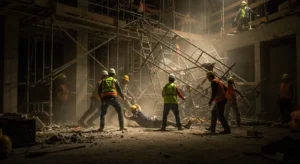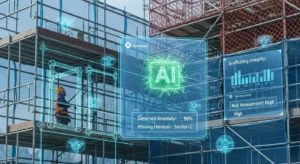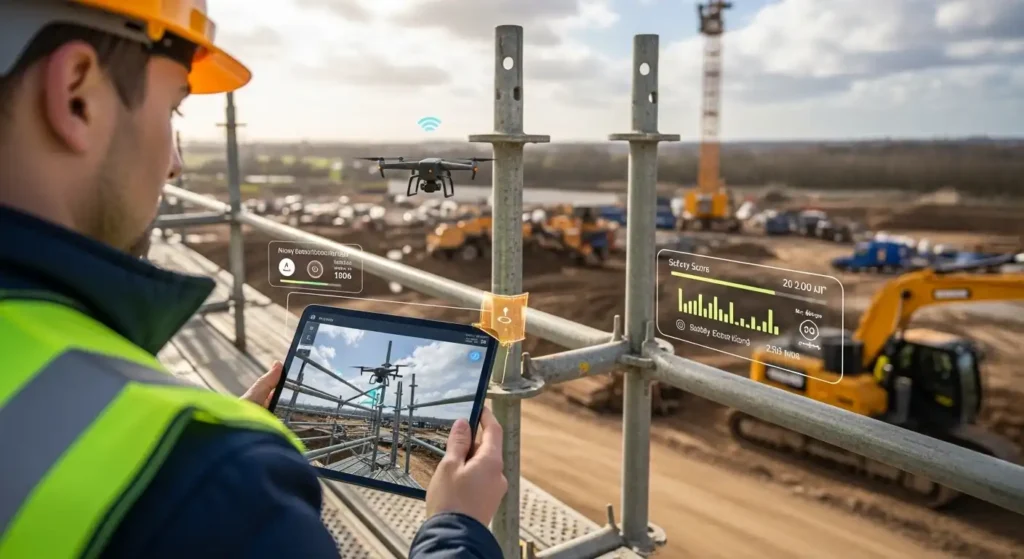Scaffolding accidents remain one of the most common and catastrophic incidents on construction sites. Despite decades of progress in safety regulation, falls, collapses, and improper assembly continue to cause severe injuries and fatalities every year. As the construction industry embraces technology, AI and computer vision systems are emerging as powerful tools for scaffolding inspection, helping detect risks earlier and prevent accidents before they happen.
The Ongoing Challenge of Scaffolding Accidents
 According to OSHA, nearly 65% of construction workers frequently work on scaffolds. Every year, thousands of workers suffer injuries from falls, structural failures, or missing safety components. Many of these incidents result from preventable causes like poor maintenance, defective parts, or skipped inspections. The complexity and scale of modern construction projects make manual inspections difficult to manage and prone to human error.
According to OSHA, nearly 65% of construction workers frequently work on scaffolds. Every year, thousands of workers suffer injuries from falls, structural failures, or missing safety components. Many of these incidents result from preventable causes like poor maintenance, defective parts, or skipped inspections. The complexity and scale of modern construction projects make manual inspections difficult to manage and prone to human error.
To improve efficiency and accuracy, the industry is turning toward artificial intelligence. These systems use advanced image recognition and 3D scanning to automatically analyze scaffolding structures and detect potential hazards — a step that could revolutionize job-site safety and reduce liability risks.
How AI and Computer Vision Transform Scaffold Safety
Artificial intelligence and computer vision tools are designed to “see” and interpret construction environments through cameras, drones, and sensors. They can identify scaffolding defects, missing braces, or improper assembly configurations by analyzing image or video data in real time. For safety officers and construction managers, this means more consistent, unbiased, and detailed inspections than traditional manual checks.
Recent innovations in AI inspection include:
- Object Detection with Mask R-CNN: A machine learning model capable of identifying and labeling scaffolding components like braces, planks, and joints in site photographs.
- 3D Point Cloud Analysis: AI systems use LiDAR or photogrammetry to compare actual scaffolding structures with approved blueprints, flagging any deviation.
- Real-Time Monitoring via Drones: Unmanned aerial vehicles equipped with vision AI can scan tall or complex scaffolding structures daily, reducing the need for risky manual checks.
- Predictive Maintenance Algorithms: Machine learning models can predict wear or failure risks based on vibration data, material age, and environmental conditions.
By integrating these systems into daily operations, construction companies can improve compliance, reduce accidents, and create reliable digital records that demonstrate safety diligence.
Real-World Applications of AI Scaffolding Safety Inspection
Several major construction and research institutions are now piloting or implementing AI inspection systems to enhance safety oversight:
- AI-powered image recognition developed by researchers in Asia and Europe uses deep learning to detect missing cross-braces with over 90% accuracy.
- Drone-based computer vision systems are now used to inspect large-scale industrial projects like bridges and power plants, identifying structural irregularities and unsafe gaps within minutes.
- Smart construction platforms integrate AI inspection results into centralized dashboards, combining site images, incident data, and worker compliance records for real-time risk management.
These examples show how computer vision doesn’t replace human inspectors — it enhances them, providing second-by-second data and catching what human eyes may miss.
Legal and Liability Implications of AI-Driven Safety
The adoption of AI in construction safety doesn’t just improve prevention — it also impacts legal accountability and personal injury claims when accidents occur. Here’s how:
1. New Evidence in Construction Accident Cases
AI-generated inspection reports and timestamped imagery can provide valuable evidence in construction accident cases. Plaintiffs may use these records to show that a company ignored warnings or failed to address flagged hazards. Likewise, contractors can use AI logs to demonstrate due diligence and compliance with safety standards.
2. Higher Standards of Care for Contractors
As AI inspection tools become widely available, courts may begin viewing them as part of a reasonable “standard of care” for major projects. Failure to adopt available safety technology could be considered negligence — especially in high-risk projects involving tall scaffolding or large crews.
3. Expert Witness Testimony and Data Integrity
In future litigation, expert witnesses may rely on AI data to analyze fault and causation. However, opposing counsel may challenge the reliability of algorithms or data collection methods, raising new questions about admissibility and accuracy. Establishing clear validation standards will be crucial for these tools to hold legal weight.
Advantages of Smart Inspection for Job-Site Safety
 The practical benefits of AI and computer vision for scaffolding inspections extend far beyond accident prevention:
The practical benefits of AI and computer vision for scaffolding inspections extend far beyond accident prevention:
- Speed: Automated scans cover entire scaffolding systems in minutes, compared to hours for manual checks.
- Precision: AI identifies microscopic cracks, misalignments, or missing fasteners that human inspectors may overlook.
- Documentation: Each inspection generates digital logs and images, offering clear proof of compliance for OSHA audits or insurance claims.
- Worker Protection: Automated monitoring reduces the need for inspectors to climb unsafe structures themselves.
- Cost Efficiency: While initial setup costs are high, fewer accidents and faster approvals lower long-term project expenses.
These advantages make AI inspection systems a valuable investment for both large-scale construction firms and smaller contractors aiming to reduce liability exposure.
Challenges and Limitations
Despite their potential, AI inspection tools come with several limitations that need to be addressed before widespread adoption:
- Environmental Factors: Poor lighting, rain, or dust can reduce camera visibility and algorithm accuracy.
- Model Bias: Some AI systems may perform poorly on new scaffolding types or materials not represented in training data.
- Cost and Integration: Setting up drones, sensors, and analytics platforms can be expensive for smaller projects.
- Legal Admissibility: Courts may require independent verification or certification of AI inspection data before accepting it as evidence.
For now, the best approach is a hybrid model—combining human oversight with AI-driven monitoring to ensure accuracy and accountability.
What Construction Companies and Workers Should Do
For construction firms, safety managers, and workers, here are some proactive steps to embrace AI safety technology responsibly:
- Adopt AI inspection tools in high-risk zones, such as multi-story scaffolding or confined spaces.
- Train safety teams on how to interpret AI results and verify findings with physical inspections.
- Store inspection data securely to maintain chain-of-custody for potential litigation.
- Regularly audit your AI system to ensure it meets OSHA and California labor safety requirements.
- Partner with construction accident attorneys familiar with AI evidence to ensure compliance and liability protection.
Conclusion
The construction industry is entering a new era where artificial intelligence and computer vision are transforming job-site safety. By applying these technologies to scaffolding inspection, companies can prevent life-threatening accidents, streamline compliance, and reduce liability exposure. For workers and injury victims, these tools can also provide valuable evidence that strengthens legal claims.
As AI inspection systems continue to evolve, one thing is clear — smarter technology means safer construction sites. Staying ahead of these innovations can protect not just your projects, but also your people.

